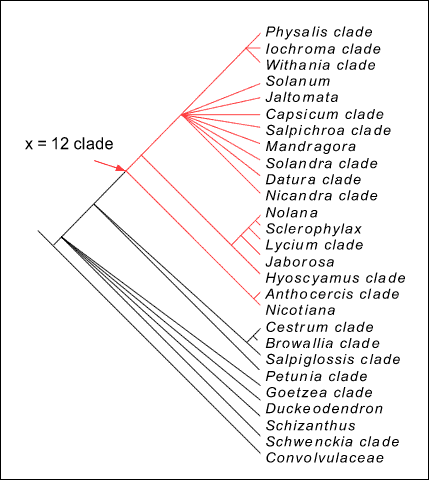With an estimated 1400 species, Solanum is the largest genus in the Solanaceae and one of the largest genera of flowering plants. Molecular phylogenetic analyses have established that the formerly segregate genera Lycopersicon, Cyphomandra, Normania, and Triguera are nested within Solanum, and all species of these four genera have been transferred to Solanum. Conversely, molecular data confirm that Lycianthes, sometimes considered to belong within Solanum, should be maintained as a separate genus.
Traditional taxonomists have recognized three subfamilies within the Solanaceae: the Solanoideae, Nolanoideae, and the Cestroideae (D’Arcy, 1979). Hunziker excludes the Nolanoideae (i.e., genus Nolana) from the Solanaceae and expands the number of subfamilies to six: the Solanoideae, Cestroideae, Juanulloideae, Salpiglossoideae, Schizanthoideae, and Anthocercidoideae. In both of these schemes, Solanum is placed within the subfamily Solanoideae, characterized by flattened seeds with curved embryos (Hunziker, 1979). Within the Solanoideae, Solanum belongs to the large and complex tribe Solaneae, which encompasses about 50 genera in the scheme of Hunziker (Hunziker, 2001).
Molecular data and phylogenetic analyses challenge the traditional view of Solanaceae subfamilies (e.g. Olmstead & Palmer, 1992; Olmstead & Sweere, 1994; Fay et al, 1998 and Olmstead et al, 1999) but the precise number of monophyletic groups in the family and their names and circumscription are still under investigation. A major finding is that member of the tribe Anthocercidae, the genus Nicotiana, and the subfamily Solanoideae (including Solanum) form a strongly supported monophyletic group characterized by a chromosome number based on x = 12 (Olmstead & Palmer, 1992; Olmstead & Sweere, 1994).

Figure 1: A framework phylogeny of the family Solanaceae.
Figure 1 shows a framework phylogeny based on the analyses of Olmstead (Olmstead et al, 1999), but using informal clade names rather than the Latinized versions of the original Olmstead paper. Family-wide phylogenetic analyses are currently in progress; Fig. 1 is a conservative view of a consensus phylogeny from published and unpublished sources and should only be regarded as a rough guide to clades within the Solanaceae.
The branch labeled Solanum in Fig. 1 includes species of the former genera Lycopersicon, Cyphomandra, Normania, and Triguera as well as the over 1000 species traditionally recognized in the genus. All species of Solanum included in molecular analyses from chloroplast and nuclear data sets form a strongly supported clade, but the sister group to Solanum is currently unclear. The Capsicum clade (Capsicum plus Lycianthes) and/or Jaltomata are the most likely candidates.

Figure 2: Schematic view of the relationships of the major clades within Solanum. See which species are found in each of the major clades.
Solanum has been divided into seven subgenera in the widely used system of D'Arcy (D’Arcy, 1972; D’Arcy, 1991), based on morphological characters and intuitive ideas of relationships. Subsequent molecular data from chloroplast ndhF sequences identify about 13 major clades within Solanum (Bohs, 2004). A schematic view of the relationships of these major clades is given in Fig. 2. Additional data are now being sought to confirm these relationships using nuclear markers and increased taxon sampling. This phylogenetic scheme will be used to order the taxa for the PBI Solanum project.
References
- Bohs, L. (2005) Major clades in Solanum based in ndhF sequences. Pp. 27-49 in R. C. Keating, V. C. Hollowell, & T. B. Croat (eds.), A festschrift for William G. D’Arcy: the legacy of a taxonomist. Monographs in Systematic Botany from the Missouri Botanical Garden, Vol. 104. Missouri Botanical Garden Press, St. Louis.
- D’Arcy, W. G. (1979) The classification of the Solanaceae. J. G. Hawkes, R. N. Lester, and A. D. Skelding (eds.), The biology and taxonomy of the Solanaceae. Academic Press, London. Pages 3-47
- D’Arcy, W. G. (1972) Solanaceae studies II: typification of subdivisions of Solanum. Ann. Missouri Bot. Gard. 59: 262-278
- D’Arcy, W. G. (1991) The Solanaceae since 1976, with a review of its biogeography. Pages 75-137 in: J. G. Hawkes, R. N. Lester, M. Nee, and N. Estrada (eds.), Solanaceae III: taxonomy, chemistry, evolution. Royal Botanic Gardens, Kew, U.K. Pages 75-137
- Fay, M. F., R. G. Olmstead, J. E. Richardson, E. Santiago, G. T. Prance, and M. W. Chase (1998) Molecular data support the inclusion of Duckeodendron cestroides in Solanaceae. Kew Bulletin 53: 203-212
- Hunziker, A. T. (1979) South American Solanaceae: a synoptic survey. J. G. Hawkes, R. N. Lester, and A. D. Skelding (eds.), The biology and taxonomy of the Solanaceae. Academic Press, London.
- Hunziker, A. T. (2001) Genera Solanacearum. A. R. G. Ganter, Ruggell. Pages 49-85.
- Olmstead, R. G. and J. D. Palmer (1992) A chloroplast DNA phylogeny of the Solanaceae: subfamilial relationships and character evolution. Ann. Missouri Bot. Gard. 79:346-360
- Olmstead, R. G., and J. A. Sweere (1994) Combining data in phylogenetic systematics: an empirical approach using three molecular data sets in the Solanaceae. Systematic Biology 43:467-481
- Olmstead, R. G., J. A. Sweere, R. E. Spangler, L. Bohs, and J. D. Palmer (1999) Phylogeny and provisional classification of the Solanaceae based on chloroplast DNA. M. Nee, D. E. Symon, R. N. Lester, & J. P. Jessop (eds.), Solanaceae IV: advances in biology and utilization. Royal Botanic Gardens, Kew, U.K. Pages 111-137
